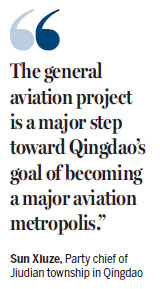New airport holds promise for future tourism
By Zhuan Ti ( China Daily )
Updated: 2017-01-26
|
|||||||||
With the installation of three new flight simulators, an ongoing general aviation development project in the Jiudian township of Qingdao, Shandong province, has once again hit the headlines of local media.
The 2.6 billion yuan ($378 million) project is planned to cover 3 square kilometers, of which 55.33 hectares, about 18.4 percent, will be used to develop a new airport named Cihang for flight training and experience, short-haul flights, business flying, emergency rescue, airborne work for farms and forestry, piloting private jets, tourism and medical services.
It will be the first of its kind in the Jiaodong Peninsula in the eastern province, said Li Pengyuan, chief engineer at the project's investor, the Qingdao Aviation Industry Investment Service Center.
Construction on the Cihang airport, situated in Pingdu, a county-level city under the administration of Qingdao, began in late December 2016 and is expected to be completed in five years, Li said.

Pingdu, on the economic circle along the Bohai Sea rim, is a manufacturing hub in Shandong with access to the province's major cities - Qingdao, Yantai and Weifang.
Jiudian, the largest township in Pingdu, has a vast land area and is rich in tourism and mineral resources to help in the project's development, Li said.
Sun Maohe, director of the Jiudian Investment Service Center, said the township is a popular tourist destination in the province, with a wealth of hot springs, gold reserves and the Party's historic heritage sites.
Developing the new project will spur the growth of local tourism, Sun said.
Pingdu received 2.68 million tourists from China and abroad in 2015, bringing in 1.23 billion yuan in tourism revenue, local media reported.
Sun Xiuze, Party chief of Jiudian, said: "The general aviation project is a major step toward Qingdao's goal of becoming a major aviation metropolis."
Revolving around the construction of the Cihang airport, the project will also include aircraft housing and maintenance facilities, flight training institutes and an aviation culture center, designers said.
Jiudian will increase its forest coverage, attract more aircraft component manufacturers and host national aviation events, the Party chief said.
"We will bring in a batch of helicopters, launch new tourism products featuring sightseeing routes in helicopters and offer emergency relief services in 2017."
Currently, a 10-minute helicopter tour costs more than 1,000 yuan in China, industrial insiders said.
In advanced countries, low-altitude flight hours for tourism generally account for roughly half of the total GApurpose helicopters' working time.
In contrast, GA operations in China work mainly for meeting industrial, agricultural, forestry and fishing farms' needs, as well as tasks for disaster relief or petroleum exploration, Li said.
"This shows that low-altitude flight tourism has enormous potential here," Li said.
The Civil Aviation Administration of China forecast the number of tourists on helicopter sightseeing tours to reach 420 million in China by 2020, forming an estimated 58.5 billion yuan market.
China's fleet of GA aircraft has maintained growth momentum, with more than 2,000 planes in service in 2015, an 8.9 percent increase from a year earlier, Chinese media reported. CAAC projected the fleet would surpass 10,000 by 2020.
"With the country's favorable policies promoting the GA sector, we will grasp the development opportunities and go all-out for early operation," Li said, adding that the maiden flight for the new airport is scheduled for June.
zhuanti@chinadaily.com.cn
(China Daily 01/26/2017 page12)




